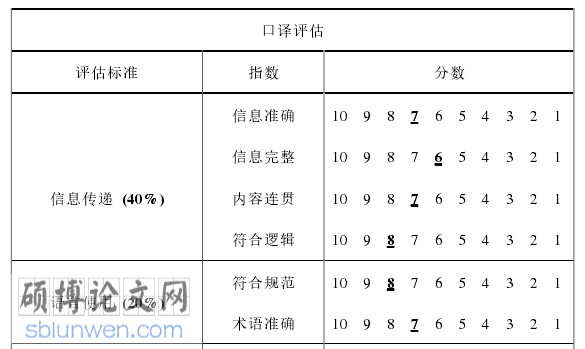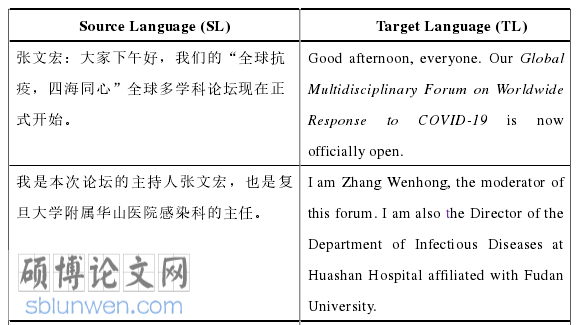1 Task Description
1.1 Brief Introduction to the Task
This report is based on a mock interpreting of the Global Multidisciplinary Forum on Worldwide Response to COVID-19. The forum, which has been held for three sessions, is a discussion by Chinese experts based on the epidemic prevention and control in different periods. The first forum is about the discussion among experts on the concrete measures China should take when the situation was still unclear. The second session focuses on the responses of different countries and regions to COVID-19. At the third forum, experts express their views on the resurgence of the epidemic. The interpreter chose the second Global Multidisciplinary Forum on Worldwide Response to COVID-19 held on March 29th as a task. The interpreting lasts for over one hour and is from Chinese to English. By inviting six experts, the forum aims to tell the public about the epidemic prevention and control. This forum is mainly to discuss the epidemic in China, Germany and the United States. Professor Zhang Wenhong and Academician Ge Junbo are the moderators. Academics like Professor Weng Xinhua also attend this forum to air their opinions. Aiming to find effective measures to contain COVID-19, the forum is also conducive to predicting the prospect and helping the public have a more comprehensive understanding of the epidemic.
............................
1.2 Features of the Task
This forum is actually an impromptu discussion among six experts. In order to make the ordinary people know more about COVID 19 and understand what the speaker says, the words which the experts use are simple and plain. However, there are still some unnecessary words, sentence fragments and semantic repetition in the source language, which are what the interpreter should pay more attention to in the interpreting process. Moreover, the topic of the forum is COVID-19, so the content is filled with academic knowledge. Accordingly, this task requires that the interpreter should have a good mastery of relevant background knowledge and terminologies about epidemic as well as related interpreting strategies. Beyond that, the experts also use metaphors and other words with Chinese characteristics to illustrate. All in all, the interpreter needs to grasp the key information and express it concisely.
There are three major reasons for choosing the task. To begin with, the reason why the interpreter chose the second forum as the task is that the virus is still spreading and COVID-19 is a global hot topic. The interpreter is highly concerned about the epidemic at home and abroad. In addition, it is an impromptu discussion conveying academic information. And the interpreter hopes that through the interpreting the public can know more about the experts’ opinions on the epidemic prevention and control as well as the prediction of prospect. Last but not least, the hard task has its depth worth study. In this process, the interpreter can make progress in both knowledge and interpreting ability as well as obtaining more experience.
............................
2 Process Description
2.1 Preparation for Interpreting
Adequate pre-interpreting preparation is essential to a smooth interpreting. It can not only help interpreters quickly predict the content in order to effectively enhance their confidence, but also improve the accuracy of interpreting. Therefore, “preparation before interpreting is an indispensable part that no one dares to ignore” (Bao, 2005, p. 76). In this part, the author mainly introduces the pre-interpreting preparation for related topics of this forum and medical terminologies.
2.1.1 Preparation for Related Topics
On the basis of the provided PPT (See Appendix D), the interpreter predicted and did some preparations carefully for the related topics at first. This forum may cover various knowledge of different areas. If the interpreter do not master the knowledge, it is difficult for her to understand the content and interpret accurately. The contents that may be involved in the prediction are: the profiles of the forum and participants, the introduction of the epidemic at home and abroad as well as the domestic and overseas development of COVID-19 in different times. The interpreter also searched a lot of information about the forum on the internet and prepared carefully according to the predicted content.
..........................
2.2 Process of Interpreting
The interpreting process lasts for over one hour, which covers three parts. There are six famous experts involved in the activity, respectively from China, Germany and the United States. First of all, the moderator gave a brief introduction to the forum and the professors to the audience. Next, the moderator invited the professors to introduce the epidemic prevention and control in accordance with the domestic and international situation. At last, the experts aired their opinions about the prospect. The interpreter’s main task is to interpret what the experts said into English. During the process of mock interpreting, the interpreter encountered such difficulties as category words, filler words, semantic repetition and structural redundancy, which posed challenges to the interpreting. However, with the unremitting efforts, the interpreter basically conveyed the key information and successfully fulfilled the task.
“Interpreting quality assessment is of pivotal importance in the research of interpreting since it indicates the success or failure of the practice and implies better solutions and advice for the next interpreting activity” (Pochhacker, 2004, p. 45). Due to mocking interpreting, the interpreter recorded the process and analyzed the transcript for several times to assess the performance in the interpreting practice. The interpreter also made a self-assessment form (see Appendix B) on the basis of the assessment scale made by Wu Wenmei from Xiamen University.

英语论文参考
.................................
3 Case Analysis ................................... 83.1 Theoretical Foundation ........................................ 8
3.1.1 Brief Introduction to Interpretative Theory ....................................... 8
3.1.2 Definition and Classification of Information Redundancy .............. 10
4 Conclusion .................................... 34
4.1 Major Findings ....................... 34
4.2 Limitations .......................... 35
4.3 Suggestions ................................. 36
3 Case Analysis
3.1 Theoretical Foundation
The interpreter elaborates the theoretical foundation so as to present the report more reasonably and logically. To begin with, the interpreter gives a brief introduction to Interpretative Theory. Beyond that, the definition and classifications of information redundancy are expounded. The third part is about the guidance of Interpretative Theory on coping with information redundancy.
3.1.1 Brief Introduction to Interpretative Theory
Interpretative Theory (the theory of sense) has played an important role in the history of interpreting. It was proposed in 1968 by Seleskovitch, who is a well-known head of the Paris School of Interpreters and Translators. Seleskovitch and her student Lederer worked together to construct the foundation of Interpretative Theory.
Seleskovitch (1978) holds the view that translation is a social communication behavior and that the need for translation first comes from the need for communication. According to Liu Heping (2011), both sides are in a common environment in the process of interpreting, and they have the relevant knowledge. Under this circumstance, the interpreter should convey meaning in a straightforward way. Interpreting is always intended to convey the meaning, so the interpreter should understand the meaning and freely express the same meaning to the audience instead of accommodating the structure and words in the source language mechanically. Combined with Saussure’s idea, the Paris School holds that interpreting can be divided into three levels featuring lexical level, sentence level and discourse level. The former two levels belong to the category of language while the level of discourse fits to the communicative context. Because interpreting is also a communicative process, it can only be conducted in the discourse level. In the interpreting process, what interpreters have to do is to seek the meaning equivalence between the source language and target language. In another word, the interpreter is supposed to convey non-verbal meaning implied in speaker’s discourse.

英语论文怎么写
4 Conclusion
4.1 Major Findings
During the impromptu discussion, the interpreter encountered many difficulties caused by information redundancy of the SL. Based on the relevant literature and feature of this task, the interpreter categorized them into four aspects, namely, category words, filler words, semantic redundancy and structural redundancy. Under the guidance of Interpretative Theory, particularly the meaning equivalence, the interpreter put forward three tactics, namely omission, compression and restructuring so as to handle above difficulties. Omission is predominantly adopted to deal with meaningless category words and filler words in the source language. Semantic redundancy can be effectively tackled with compression. Structural redundancy can be overcome by restructuring.
Interpretative Theory emphasizes to convey meaning rather than word-to-word interpreting mechanically. Strategies adopted in the re-expression stage greatly influences the quality of the interpreting output. In re-expression stage, interpreters are required to be loyal to the intention of speakers, target language and the audience. Appropriate omission and compression can help interpreters ensure the conciseness and fluency of interpreting output. Due to the differences of syntactic structure between Chinese and English as well as the different thinking pattern, some structural redundancy occurs. Therefore, the interpreter thinks that restructuring tactic should be applied in this situation, which can greatly improve the quality of interpreting.
reference(omitted)
